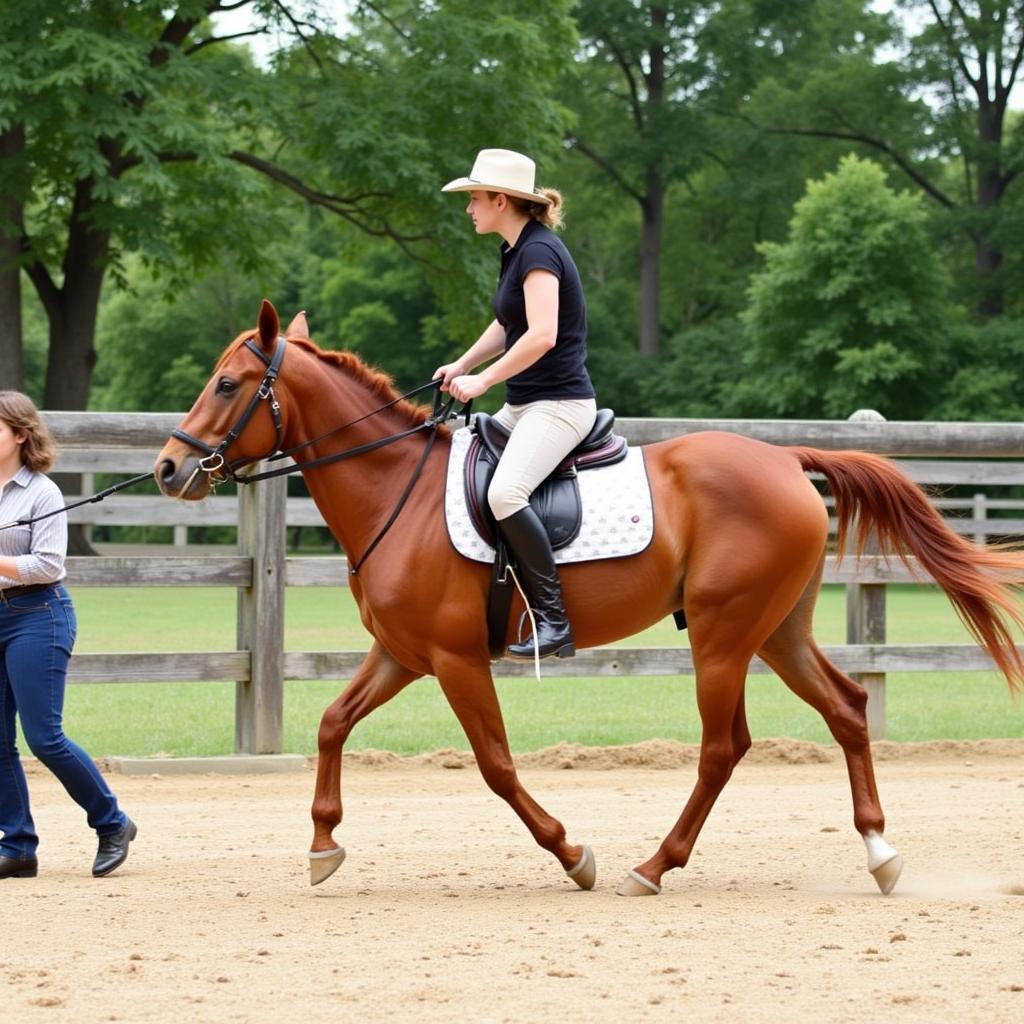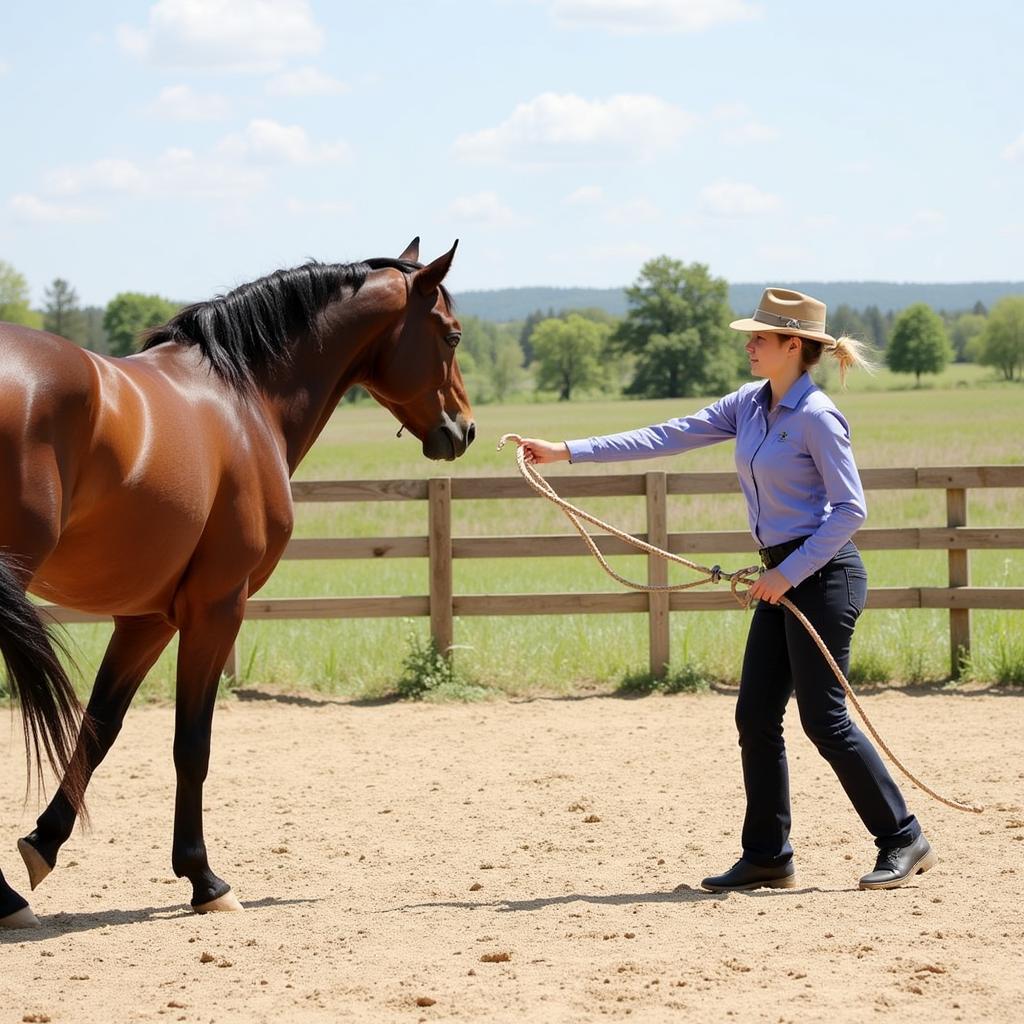Lunge Lines For Horses are an essential tool for training, exercise, and groundwork. Selecting the right lunge line can significantly impact your horse’s safety and the effectiveness of your sessions. This article will delve into the nuances of choosing and using lunge lines, ensuring both you and your horse have a positive experience.
Types of Lunge Lines for Horses
There are several types of lunge lines available, each with its own advantages and disadvantages. Understanding these differences will help you select the most suitable option for your needs.
Cotton Lunge Lines
Cotton lunge lines are a popular choice for their softness and grip. They are generally more affordable and easier to handle, especially for beginners. However, they can be less durable than other materials and may not be ideal for horses that pull strongly.
Nylon Lunge Lines
Nylon lunge lines are known for their strength and durability. They are resistant to wear and tear, making them a good option for regular use. However, their smooth surface can make them slippery, especially when wet.
Webbing Lunge Lines
Webbing lunge lines offer a good balance of strength and grip. They are generally more durable than cotton and provide a more secure hold than nylon. They are a versatile option suitable for a variety of disciplines.
After introducing a young horse to basic groundwork, a lunge line can be a great next step. It allows for more freedom of movement while maintaining a safe level of control. A lunge rope for horses is an excellent tool for introducing young horses to more advanced training techniques.
Biothane Lunge Lines
Biothane lunge lines are a newer option that is gaining popularity. This synthetic material is waterproof, easy to clean, and incredibly durable. It’s a great choice for those seeking a low-maintenance and long-lasting lunge line.
What Length Lunge Line is Best?
Choosing the correct length is crucial for effective lunging. A line that is too short can restrict the horse’s movement, while one that is too long can become difficult to manage. The standard length is typically around 25-30 feet. However, this can vary based on the size of the horse and the size of the lunging area.
Matching Lunge Line Length to Your Needs
Consider the size of your arena or lunging space. Smaller areas may require a shorter line, while larger spaces can accommodate a longer one. For training young or inexperienced horses, a shorter line may provide better control.
A lunging line for horses of appropriate length is essential for effective training. Using the correct equipment, like a proper gag bit for horses, coupled with proper lunging techniques can greatly improve a horse’s responsiveness and overall performance.
 Horse Lunging with Cotton Line
Horse Lunging with Cotton Line
How to Use a Lunge Line Correctly
Proper lunging technique is crucial for both the horse’s and handler’s safety. Holding the line correctly, maintaining a safe distance, and using clear communication signals are all essential elements of effective lunging.
Basic Lunge Line Handling Techniques
Stand in the center of the circle, holding the lunge line loosely coiled in your hand. Avoid wrapping the line around your hand or any part of your body. Use clear voice commands and body language to direct the horse’s movements.
Maintaining a Safe Distance
Maintain a safe distance from the horse, typically at least the length of the lunge whip. This helps prevent accidents and allows the horse enough space to move freely. Regularly checking the condition of your rope for horses is crucial for safety.
 Handler Using Lunge Whip Correctly
Handler Using Lunge Whip Correctly
Caring for Your Lunge Line
Proper care and maintenance can extend the life of your lunge line. Regular cleaning and inspection are essential to ensure its continued safety and effectiveness.
Cleaning and Storing Your Lunge Line
Clean your lunge line regularly with mild soap and water. Allow it to dry completely before storing it in a cool, dry place, away from direct sunlight. Inspect the line regularly for signs of wear and tear, such as fraying or cracking.
“Regular inspection and proper storage are key to prolonging the life of your lunge lines and ensuring their safety,” advises renowned equine trainer, Sarah Miller.
A war bridle for horses is another piece of equipment that requires regular care and maintenance, just like lunge lines. Ensuring that all your equipment is in top condition is vital for the safety and well-being of your horse.
Conclusion
Choosing the right lunge lines for horses involves understanding the different materials, lengths, and proper usage techniques. By following the guidelines in this article, you can select the perfect lunge line to meet your specific needs and ensure a safe and productive training experience for both you and your horse. Remember, investing in quality equipment and prioritizing safety are crucial for a successful partnership with your equine companion.
FAQ
- What is the standard length of a lunge line? Typically 25-30 feet.
- What material is best for a lunge line? It depends on your needs and preferences, but nylon, webbing, and biothane are popular for durability.
- How often should I clean my lunge line? Regular cleaning with mild soap and water is recommended.
- Can I use a lunge line for groundwork exercises? Yes, lunge lines can be used for a variety of groundwork exercises.
- How do I store my lunge line properly? Store in a cool, dry place, away from direct sunlight.
- What are the different types of lunge lines available? Cotton, nylon, webbing, and biothane are common types.
- Why is choosing the right length lunge line important? The correct length ensures both safety and effective training.
“Always prioritize safety and use proper techniques when working with horses and lunging equipment,” emphasizes Dr. Emily Carter, DVM.
For further assistance, please contact us at Phone Number: 0772127271, Email: justushorses@gmail.com Or visit us at: QGM2+WX2, Vị Trung, Vị Thuỷ, Hậu Giang, Việt Nam. We have a 24/7 customer support team.